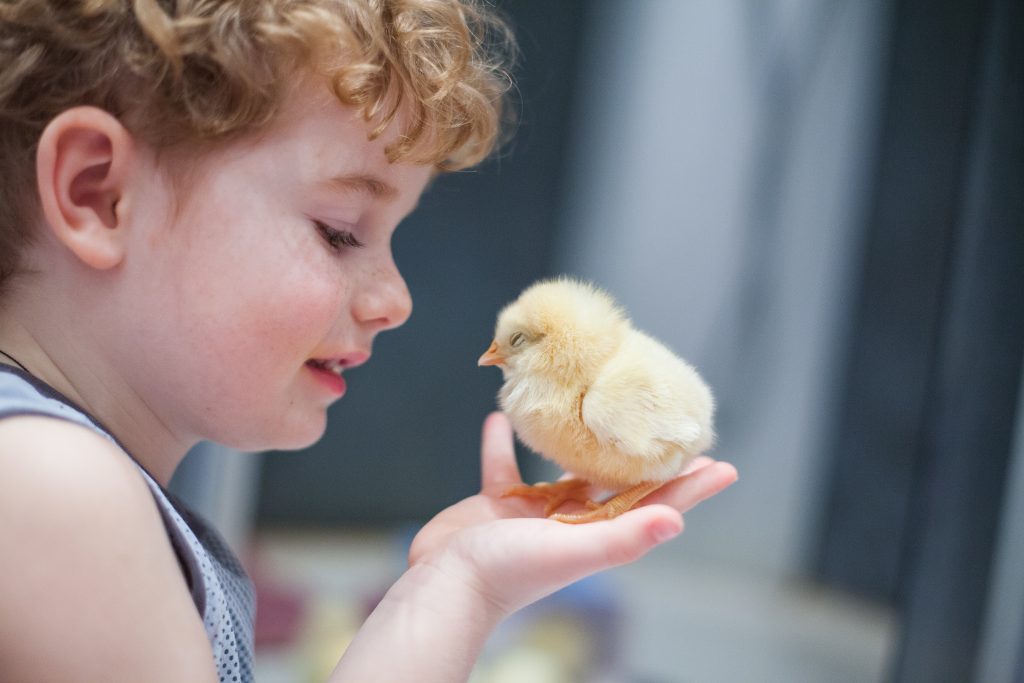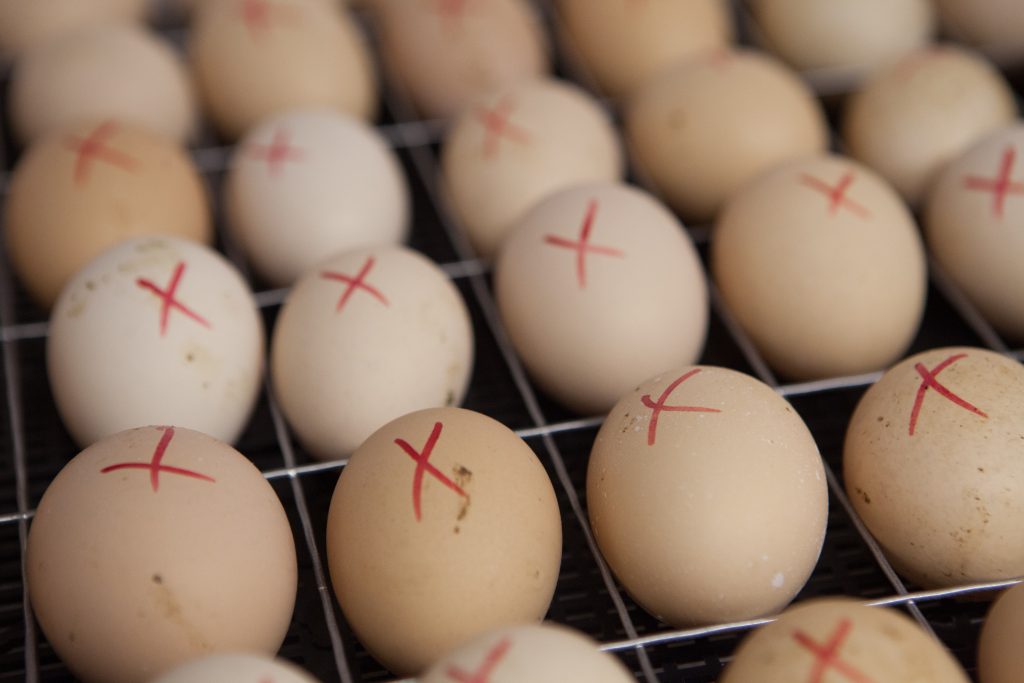Written by: Dr. Jacquie Jacob, University of Kentucky

While we consider eggs an economical, healthy food item, for the chicken they are a means of reproduction.`It is important to remember, however, that hens do not need a rooster to lay eggs and commercial laying hens are housed without roosters. As a result, commercial table eggs are not potential chicks, even if incubated. Only fertile eggs have the potential to produce chicks if given the correction incubation conditions.
The study of the development of embryos (referred to as embryology) isa fun and interesting project that can be done by al ages. When doing incubation projects with young children, make sure that they handle the chicks carefully so that they do not hurt the chick. Also make sure that the children do not kiss the chicks or touch their face with their hands after handling incubating eggs or hatched chicks. Proper hand washing is a must.

The parts of the egg are explained in detail in the article ‘How does a hen make an egg.’ Everything that an embryo needs to develop, grow and hatch must be provided in the egg when the egg is laid. If a hen receives sub-optimal feed, there may be a lot of developmental problems with the embryos when the eggs are incubated.
Despite what some people claim, it is not possible to tell if a fresh egg is fertile or not. To tell if it is fertile you will need to either break it open and look closely at the surface of the yolk, or incubate the egg a few days and candle it. When broken open, the infertile egg has a small white spot on the surface of the yolk. For a fertile egg, the spot is slightly larger and has a minute clear spot in the middle. This is the microscopic embryo.
Many birds, including all poultry species, have what is called ‘Physiological Zero.’ Fertilization occurs in the infundibulum in beginning of the female reproductive tract. It then takes about 26 hours for a hen to create a complete egg to be laid. So, when an egg is laid, it has a 26-hour old embryo. This microscopic embryo then goes into status. It does not die, but does not develop either. It waits for the correct incubation conditions. This allows a hen to lay eggs over several days and then have them all the chicks hatch out at the same time. Physiological zero also allows us to store hatching eggs prior to putting them in the incubator. The eggs should be stored at around 55F (12.8C) or slightly below. Refrigerators are typically too cold and storing eggs in your home refrigerator may result in a poor hatch. Hatchability is reduced when eggs are stored for longer than ten days.
Physiological zero for chickens is 68F (20C). The ideal incubation temperature for chickens is 99-100F (37-38C). If the egg is heated to above physiological zero but below optimal incubating temperature, some embryonic development can occur but will result in weaker embryos and higher embryo mortality.

The amount of time required for incubation and hatching of poultry eggs depends on the species and are shown in table below.
| SPECIES | INCUBATION PERIOD (Days) |
|---|---|
| Chicken | 21 |
| Duck (except Muscovy) | 28 |
| Muscovy duck | 35 |
| Goose (except Canada and Egyptian) | 28-32 |
| Canada and Egyptian Geese | 35 |
| Turkey | 28 |
| Quail - Bobwhite | 24 |
| Quail - Japanese (Cortunix) | 16-18 |
| Guinea fowl | 28 |
| Chukar partridge | 24 |
| Pheasant | 24 |
| Peafowl | 28 |
| Pigeon (For comparison) | 17 |
During embryo several ‘extra-embryonic’ membranes are developed. These include the yolk sac, amnion, chorion and allantois. The yolk sac is the membrane that spreads over the yolk and transports nutrients from the yolk to the embryo. The amnion is the fluid-filled sac that covers the embryo to protect it from physical shocks and injury. The chorion and allantois membranes combine to form the choir-allantoic membrane that performs four functions. It is a respiratory organ that provides oxygen to the embryo. It is a storage area for the waste products that the embryo develops. It provides nutrients from the albumen to the embryo. It also brings calcium from the eggshell to the embryo.

Incubating eggs should be turned regularly from day 2 to 18. If not using an automatic turner, a minimum number of turns is recommended. For chicken eggs, the minimum is three times per day. Typically an X and O are marked on either side of each egg and the eggs rotated back and forth three times daily.

When using automatic turners, chicken eggs are typically turned every hour. They are placed in the incubator on a 45-degree angle and turned 90 degrees back and forth every hour.

Turning the eggs is stopped at 18 days of age. This is the time when the eggs are transferred from the incubator to the hatcher. During this time the embryo is getting into position to break out of the shell. It must be in the correct position to hatch. Its beak is under its right wing with the beak pointing towards the air space. To break out of the shell, the embryo breaks through the shell membrane and enters the air space. This is referred to as internal pipping. At this time the chick goes from embryo to chick as it starts to breathe with its lungs. The level of carbon dioxide in the air space builds up as the chick continues breathing. This stimulates the chick to break out of the shell. It breaks through the shell (called pipping) using its ‘egg tooth’ (a hardened material on the tip of the chicks beak and lost shortly after the chick hatches) and cuts around the surface of the shell. It then pushes itself out of the shell. Of course, this is hard work and the first thing the newly hatched chick wants to do is rest. They soon dry and are able to move about.

Chicks that are able to get up and move around shortly after hatch are referred to as precocial birds. Those that require further development after hatch and are dependent on their parents to bring them food are referred to as altricial. An example of an altricial poultry species is the pigeon.
During incubation, the embryo develops in a predictable manner with specific effects occurring at specific times. The times for different poultry species will vary depending on the overall incubation time. The timing for the development of the chick embryo is shown below:
| TIMING | EVENT(S) |
|---|---|
| Before the egg is laid | Union of the ovum and sperm (fertilization) |
| From lay to incubation | Embryo is status with no development |
| Day 1 of incubation | Head begins to form Eyes begin to form Vertebral column (spine) begins to form |
| Day 2 | Blood vessels form Heart begins to beat Ears form |
| Day 3 | Limb buds are visible Extra-embryonic membranes begin to form |
| Day 4 | Eye pigmentation begins Tongue begins to form |
| Day 5 | Reproductive organs begin to form |
| Day 6 | Beak begins to form |
| Day 7 | Egg tooth is easily seen Segments of wings and legs are distinct Feather tracts are present on the back |
| Day 8 | Feather tracts more visible |
| Day 9 | Toes are formed |
| Day 10 | Beak begins to harden |
| Day 12 | Down present on body Eyes nearly closed Scales begin on shanks |
| Day 14 | Eyes closed Embryo turns to point head at air cell |
| Day 17 | Head of embryo under right wing |
| Day 19 | Yolk sac enters body |
| Day 20 | Yolk completely in body cavity Chick pips air cell and then eggshell |
| Day 21 | Chick hatches |
When using incubators, they can be still-air or force-air. As the names would indicate, still-air incubators do not have a fan for movement of air inside the incubator, while force-air incubators do. For chickens, the temperature should be 100-101F (37.8-38.3C) while in a force-air incubator it should be 99-100F (37.2-37.8C). Below optimal temperatures will result in abnormal embryo develop and possibly death. Overheating will also reduce the number of chicks that hatch.
The relative humidity inside the incubator is important to regulate moisture loss from the incubating eggs. For chicken eggs, the relative humidity should be 70 percent. It will be a little higher for waterfowl. Pans of water can be placed in the bottom of incubators to help increase relative humidity inside the incubator.
Each incubator is equipped with ventilation holes which should be opened to allow fresh air to enter the incubator.
Embryo development is a fragile process that can be easily disrupted. Many problems are related to improper temperature, humidity, ventilation and turning during the incubation process. A list of common incubation problems and their causes are given in the table below:
| SYMPTOMS | POSSIBLE CAUSES |
|---|---|
| Many eggs with no embryo | Nutritional problems with parents Eggs stored too long Eggs stored above 55F (12.8C) |
| Blood rings | Improper incubation temperature Improper care of eggs |
| Dead embryos | Temperature too high or too low Improper turning of eggs Poor ventilation |
| Chicks breaking through shell (pipping) but not hatching | Low humidity in the hatcher |
| Chicks hatching too early | Temperature too high |
| Late pipping of eggs | Temperature too low |
| Eggs pipped by chick but take a long time to hatch | Temperature too high |
| Short down on chicks | High temperature Low humidity |
| Rough navels | High temperature Low humidity |
| Shell sticking to chicks | Low humidity in the hatcher |
| Mushy, bad-smelling chicks | Bacteria in the incubator |
| Crippled and deformed chicks | Heredity Nutrition problems with parents |

ADDITIONAL RESOURCES
Hatching eggs in the classroom: A teacher’s guide (Texas A&M University)
Chickscope (University of Illinois)
Eggcellent adventures in classroom embryology (University of Florida)
Hatching my peeps embryology countdown calendar (University of Florida) – for purchase

